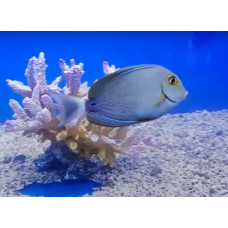Latin name
Acanthurus nigricauda
Other name
Black-barred surgeonfish, eye-line surgeonfish, shoulderbar surgeonfish, white-tail surgeonfish, blackstreak surgeonfish.
Identification
It is a fish with a thick body compressed from the sides. The profile of the head is convex, the eyes are rather convex and there are two pairs of nostrils just in front of the eyes. The body is covered with small scales, giving it a smooth appearance, and the lateral line is indistinct.
Features of fish fins
The dorsal fin has 9 spines and 25 to 28 soft rays, and the anal fin has 3 spines and 23 to 26 soft rays. The caudal fin is sickle-shaped.
Fish colouring
The head is usually lighter than the body, which is a uniform color, but can vary from light gray to dark brown or almost black, depending on the mood of the fish. There is a distinct black band behind the eye, an "epaulet" extending to the eyelid, and a thin black line in front of a pair of sharp "scalpels" on the caudal peduncle. The dorsal fin is yellowish with a black stripe and blue edge, and the anal fin is gray with a blue edge. The pectoral fins have an orange base and a gray, yellow and translucent border, and the caudal fin has a white base and a dark outer portion with a blue border. A. nigricauda can be distinguished from the similar Acanthurus tennenti by a single "epaulette" on the head.
Distribution
Acanthurus nigricauda is found in the tropical and subtropical regions of the Indian Ocean and the western and central Pacific. Its range extends from East Africa and Madagascar to the Tuamoto Islands and from southern Japan to northern and eastern Australia and New Caledonia.
Habitat
A tropical brackish water species. It occurs on sandy and rocky bottoms, in bays, lagoons, and on reef slopes, at depths down to 30 m (100 ft). Unlike most other members of its genus, it is rarely found on corals.
Size
Reach a maximum length of 40 cm (16 inches). Maximum declared weight of 2.7 kg.
Behavior
A gregarious fish that forms schools, sometimes in association with Acanthurus olivaceus. The scalpels on the caudal ramus are retractable and very sharp. They are displayed when the tail is pulled to the side and are used to attack rival fish and to defend against predators.
Food and feeding habits
They feed on algal films that grow on sandy areas near corals or rocky outcrops, but the amount of algae in their stomach is small, they feed mainly on organic detritus that is trapped in the film.
Reproduction
This species has separate sexes, and both sexes reach maturity at about 15 cm (6 inches) in length. During breeding, the fish gather in large aggregations, with both sexes releasing their gametes into the water column. Juveniles are shorter and denser than adults. They are dark brown at first, with a yellowish caudal fin without spots, and gradually change color when they reach a length of 5 to 10 cm (2 to 4 inches).
Fishing
Of commercial interest for fishing. It is caught in nets.
Relationship with a person
This species is sometimes poisonous.
| Classification | |
| Phylum | Chordata |
| Class | Actinopterygii |
| Squad | Acanthuriformes |
| Family | Acanthuridae |
| Genus | Acanthurus |
| Species | A. nigricauda |
| Features | |
| Conservation status | Least Concern |
| Habitat | Pelagic |
| Life span, years | No information |
| Maximum body weight, kg | 2,7 |
| Maximum length, cm | 40 |
| Sailing speed, m/s | No information |
| Threat to people | Edible |
| Way of eating | Planktonophage |
Epaulette surgeonfish
Tags: epaulette surgeonfish



